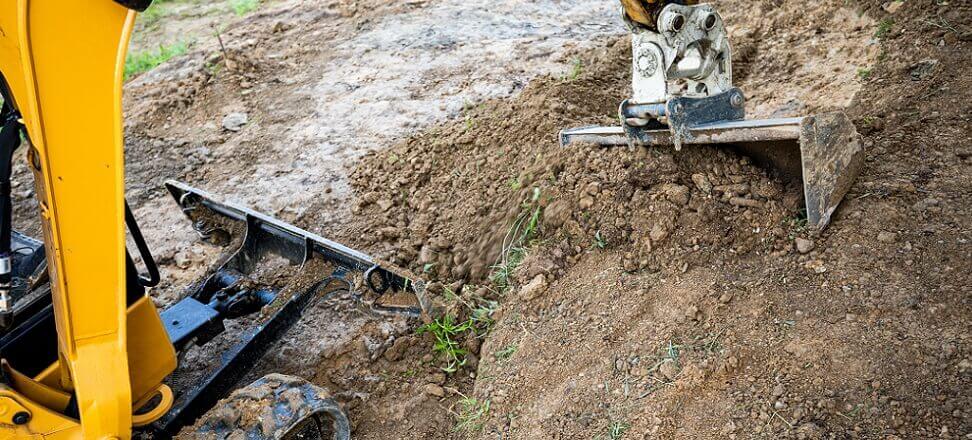Feedback
Earthworks in the vicinity of water bodies – legal basis
Properties located in the vicinity of water reservoirs are highly developed for both recreational and economic purposes. Effective use of them very often involves land leveling and the application of earth masses for leveling. In practice, however, it is very often forgotten that earthworks must meet the standards of the provisions of the Law of December 14, 2012. on waste (Journal of Laws 2023, item 1587) and Law of July 20, 2017. Water law (Journal of Laws 2023, item 1478, as amended). Therefore, it is worth recalling them and noting what restrictions apply.
Landmass vs. waste
In the process of land leveling, earth masses are very often used. Analyzing the possibility of their use in the land development process, it should be recalled that according to the provisions of Art. 2(3) of the Waste Act, the provisions of this law do not apply to “uncontaminated soil and other naturally occurring materials excavated during construction work, provided that the material is used for construction purposes in its natural state on the site where it was excavated.”
Therefore, the case law emphasizes that “The provisions of the 2012 Law. on waste do not apply only to uncontaminated soil and other naturally occurring materials excavated in the course of construction work, only if they will be used for construction purposes in their natural state and on the site where they were excavated (emphasis K.G). So, the soil and materials must be used, first, for construction purposes and, second, in the area where they were excavated. (Judgment of the Supreme Administrative Court of 19.04.2018, II OSK 2655/17, LEX No. 2493927).
Therefore, if earthworks were to be carried out outside the boundaries of the property where the earth masses were created, the material will be treated as waste. Accordingly, the entity intending to use it, whether or not it is business-related, will have to comply with the requirements applicable to waste management.
Before using the land masses, it must obtain a waste collection or processing permit under Art. 41 para. 1 of the Waste Law. Exceptions to this rule were introduced by a decree of the Minister of the Environment dated November 10, 2015. On the list of types of waste that individuals or organizational units (that are not entrepreneurs) may recover for their own use, and permissible methods of recovery (Journal of Laws 2016, item 93). It defines a closed catalog of waste and methods that can be used without the need for a permit.
For example, it was pointed out that in the case of waste earth masses, the ratio for this type of use is 200 kg/m2. Therefore, if, for example, an individual, who is not an entrepreneur, wants to use waste earth masses in a smaller quantity, he will be able to do so without having to obtain a permit. However, if the rate of waste used would be higher, then a permit is necessary.
Use of waste in the vicinity of water bodies
However, the lack of the need to obtain a permit for the use of waste for land leveling does not relieve the need to comply with other legal restrictions. From the point of view of waste use in the vicinity of water bodies, it is first necessary to recall the restrictions of Art. 77 paragraph. 1(1) of the Water Law, according to which it is prohibited to introduce waste into the waters as defined in Art. 3 paragraph. 1 point 6 of the Law. Therefore, if the land records show that there is a body of water at the site, conducting earthworks, it means that the use of waste in the area, regardless of its type, will be prohibited.
Speaking of the boundaries of water bodies, one should also not forget the provisions of Article 220(1) of the Water Law, according to which “The shoreline for natural watercourses, lakes and other natural water bodies shall be the edge of the bank or the line of permanent grass growth or the line that is determined according to the average water level of at least the last 10 years.” In practice, therefore, an entity carrying out waste earthworks in the vicinity of water bodies will have to precisely establish their boundaries. Otherwise, it may turn out that it is carrying out work in the area of a water body, and therefore in violation of the applicable rules.
The introduction of waste into waterways (even if the waste is temporarily not present) constitutes an offense under Art. 478(6) of the Water Law, punishable by a fine. Keeping in mind these restrictions, it is important because the prohibition on the introduction of waste into water is absolute and applies even if the waste is used in a way that does not require a permit. Nor is obtaining such a decision exempt from its obligation. Unfortunately, this is often forgotten in practice.
Earthworks and change of water relations on the land
When planning earthworks, one should also not forget about the restrictions under Art. 234 para. 1 of the Water Law, according to which “A landowner, except as otherwise provided by law, shall not:
- change the direction and intensity of the outflow of rainwater or snowmelt located on his land, or the direction of the outflow of water from springs – to the detriment of neighboring land;
- discharge water and introduce sewage onto neighboring land.”
In practice, it is emphasized that: “In the case of damage related to the change of water relations on the land, any action that results in a quantitative change in water (i.e., an increase or decrease in the amount of water on the land) and a change in the flow of water through the land can be considered a change. Thus, it is such an activity that interferes with the natural state of water in a given area related to its terrain, natural and hydrological conditions.
This change may consist in changing the direction of the outflow of rainwater located on the land or the direction of the outflow from springs by, for example: making an obstacle to the outflow of rainwater from neighboring land; filling the land to raise the land; removing the land to lower the land; digging a ditch; backfilling an existing ditch; paving the surface of the plot with paving stones; erecting a brick fence; digging a well and drawing from it such an amount of water that will lower the water table on neighboring land. A change in the direction of water runoff – within the meaning of Article 234 of the Act – is also a change in the angle of water slope.” (Judgment of the WSA in Gliwice of 22.09.2023, II SA/Gl 647/23, LEX No. 3618498).
Therefore, when carrying out work such as leveling, it is also necessary to assess whether it will alter relations on the land. Adherence to waste use standards (including waste earth masses) does not guarantee that it will not lead to changes in water relations on the land. Indeed, this circumstance is not analyzed in the process of issuing decisions that form the basis of waste management. If, on the other hand, the earthworks will cause changes in water relations, under Art. 234 para. 2 of the Water Law, an obligation may be imposed on the owner to restore them.
Conclusions
Therefore, summarizing the above considerations, it must be said that the use of waste in the vicinity of water bodies must be done with extreme caution. Indeed, restrictions on this may arise from both the regulations that underpin water management and waste management. Meeting only the latter does not guarantee consideration of all constraints. Therefore, in the future, it is worth introducing conflict rules, specifying, for example, how the impact on water should be taken into account in the decision-making process that forms the basis for waste management.

 Polski
Polski







